
How Do Tone Capacitors Work?
The Tone Cap is an incredibly useful tone-shaping tool. Understanding the basics will help you choose the right tone cap for your style. There are a ton of variations of this simple component – from the super basic models to more boutique “oil and paper” versions – but which one to choose? Let’s dig in a little bit and figure out what a tone capacitor is doing to your guitar signal first!
TONE CAP BASICS:
Capacitance is defined as “the ability of a component to store an electrical charge”. A Capacitor is a device that stores electricity. Capacitance is measured using Farads – from Picofarads to Kilofarads – from very, very small to very large. The larger the capacitance, the more electricity it can store, and the longer it will hold its charge.
Under the hood, a Capacitor is a very simple device. It consists of two terminals, or legs, both attached to a metal plate, separated by an insulator. The metal plates are what hold the charge, and never touch each other. See below for an illustration!
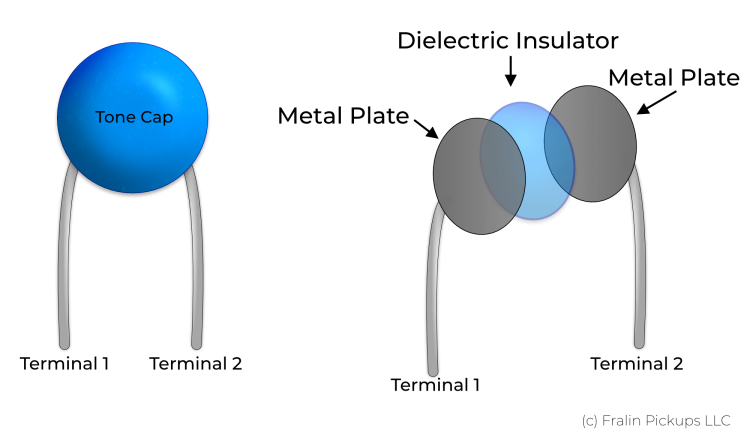
The Tone Capacitor has Terminal 1 heading into a Metal Plate, which is very close to (but not touching) Metal Plate 2, which is connected to Terminal 2. As electricity (electrons, charged negatively) move into Terminal 1, it saturates the plate, which is sensed by Metal Plate 2, and results in a positive charge that moves down terminal 2 (Think magnets – Negative and Positive attract). After a certain point, Metal Plate 1 is saturated with electrons and starts to impede or resist any incoming electricity.
So, we’re not going to get all greasy with the electronics here. There are plenty of well-written articles out there if you want to understand this more. But, we are going to talk about how this applies to the guitar because we love guitars!
HOW DOES A TONE CAP WORK IN A GUITAR?
The idea that the tone cap will in time impede electricity is very important to understand how a tone cap works for your guitar. In the simplest of terms, a Tone Cap will impede low frequencies, and allow higher frequencies to pass through.
But, how does it apply to the guitar? Most guitar players have a Tone Pot, which is nothing more than a regular volume pot, with a Tone Cap soldered on to it (read more about selecting pot values and how pots where here). One Terminal solders on one of the Lugs of the pot, the Other Terminal connects to Ground. See an image below on wiring, and how it works. Note: The Red Arrow denotes which way you turn the knob, the Pot itself is shown upside down, like you’re looking at it from the back of the guitar.
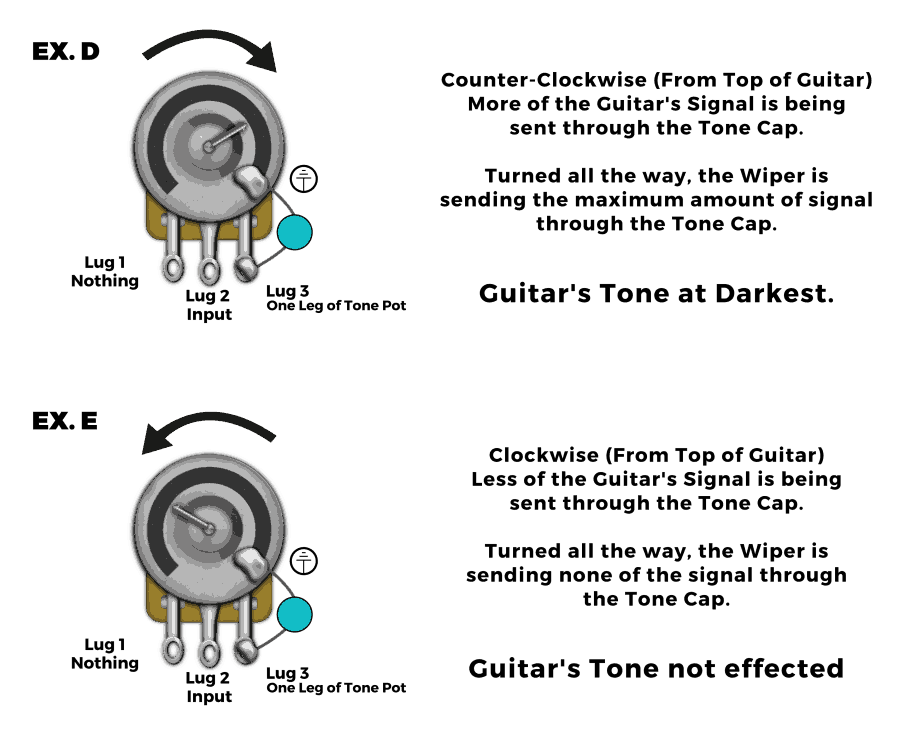
The more you turn back the Tone Pot, the more the “Input” lug connects to the right-most lug. What this is doing is sending more electricity through the tone cap. The tone cap is impeding low frequencies but allowing the high frequencies to pass through to Ground. This gives you that “rolled-off” darker tone. It’s not actually making your guitar darker, it’s passing the highs to Ground, where they won’t enter the signal path anymore.
WHICH TONE CAP VALUE TO CHOOSE?
As stated earlier, there are a plethora of tone caps available at your disposal. Most of the time, we’re talking about Microfarads. We, as guitarists, have found this capacitance level the most useful for shaping your tone. Our lowest value tone capacitor that we have is our Fralin Magic Cap, which is .0015 Microfarads (mfd). This low capacitance cap really doesn’t roll off a ton of highs – it’s impeding most of the pickups’s signal, only allowing a little to pass through to Ground.
Larger value caps will reject less of your pickup’s signal, and allow more to pass to Ground. For instance, Fender historically used .047mfd, .1mfd, and .02mfd as a standard cap value, and Gibson has used .022mfd and .047mfd as a standard cap value. A larger cap value (.1mfd) will start to roll off high frequencies faster, and go deeper into the midrange than a lower cap value (.02mfd).
The higher the value of cap, the deeper the roll-off of high frequencies will be. A .02mfd Cap will roll off just your highs, where a .1mfd will roll deep down into your midrange.
Let’s give some of these a listen:
WHICH TYPE OF CAP TO USE?
There are, again, a plethora of them out there. From the circular tone caps to the cylindrical oil and paper caps, some caps going for well over $100 for them, there’s enough to make your head spin. We could spend all day comparing these, but what Lindy says is this:

So, for our sake, we prefer the more affordable simple caps, pictured above. They’re good enough for us, but, we’d love your thoughts as well. Let us know what cap value you like below!
Comments
23 Comments For This Post
Leave A Comment
Want to chime in to the conversation? Please do so! Please respect others.



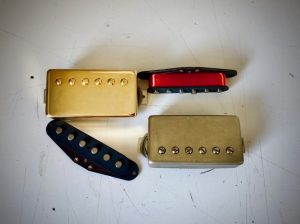
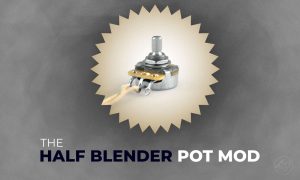
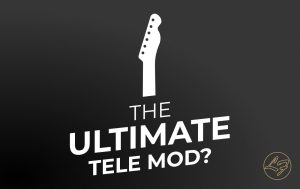
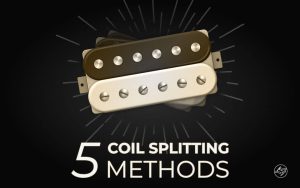
I finally have my Strat together with the Blues Special pickups installed. I am blown away by the varied sonic control just having the Magic Cap installed. It is usable in all positions and that is impressive. Makes me think of it as a tone sweep instead of a rolling off of the highs. Thanks.
Howdy friends!
I have a tele type guitar with 2 humbuckers mounted to the body, wired to a 3 way switch and 250k volume pot. I love the simplicity and am wondering how I can filter out low end from the neck pickup? Anything I put in the neck has wayyyy to much low end.
Using PAF style/ output pickups. Any info is much appreciated!!
Randy
Waukesha WI
Greg Piette is thinking the pickup is like a coil of a crystal radio which has it’s resonant frequency altered by either the number of turns in it’s coil and by the value of the capacitor across that coil. While that’s interesting it doesn’t explain how the same tone circuit can work on your MP3 player to alter the tone when the MP3 player has no tank circuit coil. Nor does a tape player, a stereo radio, a turn table or many other forms of audio reproduction. Obviously it’s not functioning as a LC tuned circuit.
Hey Tyler,
How does the voltage work in capacitors, I noticed there’s 100v and 200v?
Thanks again, Sean
In response to ricks comment above. That not correct. The signs is not passed through the tone cap, did it’s not a “low pass” cap, but it does in conjunction with the pot, act as a low pass filter circuit…. If that makes sense.. The capacitor itself impedes low freqs, allowing the highs to pass through to ground, instead of passing through to the output jack and amp.. The articles explanation is correct, albeit kinda confusing.
Boy, it’s a good thing he didn’t go into the difference a 500k pot vs. a 250k pot make on tone control. I’m still trying to figure out why I’ve sometimes seen a resistor on one leg and a cap on the other.
Overall nice job. The references to high and low frequencies are reversed in two places. Please check and make sure that filter roles and frequencies are stated correctly, i.e. clarify that the tone control is a *low-pass* filter that allows *low* frequencies to pass and “rolls off” high frequencies.
This is a response to Brat T.
You’re right and wrong. What a cap does in a guitar is help create an LC-tuned circuit. This circuit in the way that it acts, ” traps out ” the frequencies depending on the L value of the pickup and the C value of the capacitor. It is important to remember that the signal coming from/or generated by the pickup is an AC signal. AC signals can ‘pass through’ a capacitor depending on the value of the capacitor in conjunction with the pickup’s L value. We are dealing with ‘reactances NOT resistances’. SO there you go…I’m sure you’re even more confused. Electrical Engineering classes were definitely mind stretching to say the least! 🙂
Does nobody understand how a cap works. NOTHING passes thru it it can’t as there is NO internal connection between the terminals. They charge and dis-charge. their ability to do this is what affects the frequency and it’s measured in mf’s, re-guardless of material.
Please don’t use mfd as the symbol for micro Farads. The correct symbol is uF. If someone orders a 0.02 mfd cap from an electronics supplier, they could get a 0.02 milli Farad cap. Not the same thing as the 0.02 uF cap they want.
Hello Tyler, thank you so much for taking time for making this articles.
Simple question here. I see capacitors connected from on lug of the tone pot to the casing of the same tone pot and other capacitors connected from one lug of the tone pot to one lug of a volume pot. What is the correct way? There is cons and pros? do you recommend any method?
Thanks in advance
Hey Alberto, thanks for the kind words. There is no difference in tone to our ears. On our prewired pickguards and control plates, we hook them up differently. It’s really just personal preference.
I got a CDE716P600V 473J 1323 with my blues special tele pickups . Is that the one that goes far right on volume to the far left on the tone ? right now I have a 223 K 630 v with a 5 position switch . I was told to snip the ground on the Neck pickup cover . They call it a serial killer control plate made for 2 pickup tele . I want to thank you for the capacitor with the blues special pickups too ! Still building tele but getting close to having a one of a kind . It’s the second Lindy Fralin pick up set I’ve got . This set is for me.
It would be nice to add a chapter about how to use capacitors to cut the bass to give muddy pickups more clarity either combined with a fixed value resistor or a pot.
Really Enjoyed this video. Can you do one for Bass Guitars as well?
Adam
Is orientation of the leads in relation to signal path important. It seems this detail is seldom mentioned.
BTW, your site is fantastic! Thanks for the tutorials.
No, orientation of the leads is not important unless it is a polarized cap, then yes. Generally speaking caps used for guitar tone pots are not polarized.
Even though they are non-polarized, many of the capacitors used for guitar tone capacitors use a rolled construction, with one lead connected to the inner foil and one lead connected to the outer foil. It can be demonstrated that if the outer foil lead is connected to the point in a circuit that has the lowest impedance to ground (in the case of a guitar tone cap that is ground) the capacitor effectively becomes screened and will pick up less hum. If the cap is installed in a well screened control cavity, grounding the outer foil lead may not provide any advantage.
Hi Tyler,
I understand how the no-load pot works, but I am interested in knowing if the no-load signal improves the clarity and articulation of the Fralin bass pickups. Or are the Fralin P bass pickups tonally designed to compensate for a “normal” loaded tone pot, resulting in a no load signal that sounds comparatively brittle, unbalanced, or in some way unpleasant?
I asked this because I just ordered a stock wound Fralin P bass pickup. I purchased a Fender/CTS no-load tone pot to pair with your pickup (thinking this would give me an ultra pure tonal option). But, if you guys know in advance that the Fralin P bass pickups don’t pair well with no-load pots then it would be of great benefit for me to know that now.
Thanks…John
Tyler,
Will the no load tone pots also yield pleasing results with your stock wind P Bass pickups? Or is the no load tone pot not advisable with your bass pickups?
Thanks,
John
John,
No Load pots will have a tonal effect on any instrument you put them on – just note that the tone pot doesn’t load the signal like the volume pot does.
Tyler
but my telecaster sounds so good when I bypass the damn cap all together. Are they completely necessary in every situation?
Lee,
They are not completely necessary, but you can always opt for a No-Load tone pot and it will be removed from the circuit when it’s on 10.
Tyler